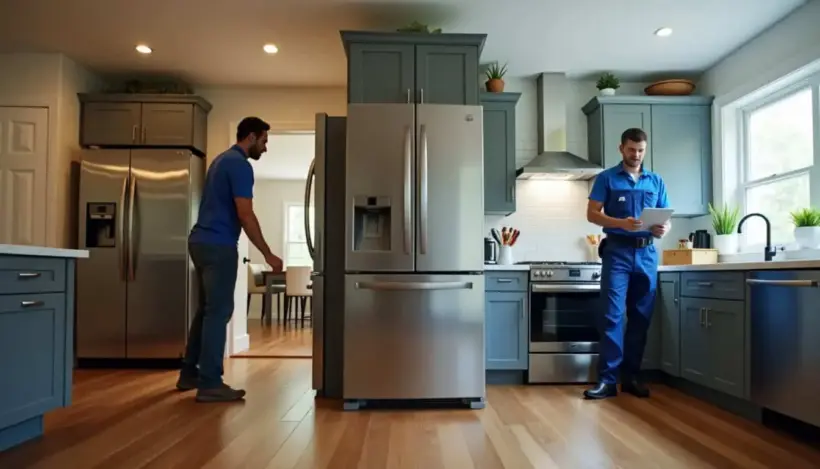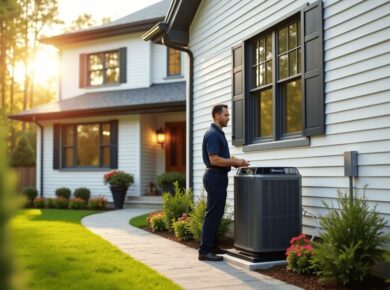Table of Contents Show
Smart homeowners save 1% to 3% of their home’s purchase price each year for maintenance and repairs. But appliance breakdowns can quickly drain these savings, and that’s why many homeowners choose Cinch home warranty to protect their investments.
Cinch Home Services is a 40-year-old powerhouse in the home warranty market. The company’s 180-day repair guarantee stands out from competitors who only cover repairs for 30 to 60 days.
Plans cost $30.99 monthly with service fees ranging from $100 to $150. The company serves customers in 48 states and Washington, D.C. Their $10,000 coverage cap covers all claims together, unlike other providers who put limits on individual items.
You might wonder if this experienced warranty provider is right for your home systems and appliances. Our detailed review examines Cinch’s coverage options, costs, and customer savings to help you decide.
What Is Cinch Home Warranty and How Does It Work?
Cross Country Home Services rebranded itself as Cinch Home Services in 2019 to show its dedication to making home protection easier. The company has grown substantially, and its size has doubled in four years with annual revenue approaching $500 million.
Company Background and History
Cinch Home Services, a 45-year old company, stands as a major player in the home warranty sector. They handle over 1 million service requests each year through their network of vetted service providers nationwide. Their exceptional service has earned them multiple Stevie Awards for customer service excellence and ConsumerAffairs Buyer’s Choice Awards.
Basic Coverage Overview
A Cinch home warranty serves as a yearly service agreement that takes care of repairs and replacements for home systems and appliances with normal wear and tear. The coverage extends to 25 different home systems and appliances.
The service process works smoothly:
- Homeowners submit a claim online or by phone after a covered item breaks down
- A verified service provider gets contacted by Cinch within two hours during business hours
- Service providers set up an appointment time
- Teams complete repairs or suggest replacement options if repairs aren’t possible
Cinch sets itself apart by covering unknown pre-existing conditions and backing work with a 180-day guarantee. The company steps in where homeowners insurance usually doesn’t help, such as appliance breakdowns and system malfunctions.
You May Also Read: First American Home Warranty Revires
Modern technology helps boost Cinch’s customer experience. A self-service portal lets homeowners track claim status, and Amazon Alexa integration enables coverage checks and claim submissions. Protection starts 30 days after the original payment, giving homeowners year-round coverage.
Breaking Down Cinch’s 3 Home Warranty Plans
Cinch has three different home warranty plans that fit various homeowner needs and budgets. You can get coverage from simple appliance protection to complete home system coverage, with monthly premiums starting at $30.99.
Appliances Plan ($30.99/month)
The Appliances Plan protects your essential household equipment. This starter plan covers major kitchen appliances whatever their age or make. You can protect up to two units of each covered appliance. The coverage has:
- Kitchen equipment (refrigerators, dishwashers, built-in microwaves, ranges)
- Laundry machines (washers and dryers)
- Additional items (trash compactors, built-in food centers)
Built-in Systems Plan ($35.99/month)
The Built-in Systems Plan costs $35.99 per month and protects your home’s core infrastructure. The plan covers three major categories:
Cooling and Heating Systems:
- Central air units and heat pumps
- Electric baseboards and floor furnaces
- Forced air systems (gas, electric, oil)
Electrical Components:
- Built-in exhaust and vent fans
- Ceiling fans and central vacuums
- Garage door openers and doorbells
Plumbing Infrastructure:
- Standard and tankless water heaters
- Drain and sewer systems
- Permanently installed sump pumps
Complete Home Plan ($44.99/month)
The Complete Home Plan starts at $44.99 monthly and combines both appliance and system coverage into one complete package. This premium option has exclusive benefits:
- Homeowners insurance deductible reimbursement up to $500 per year
- Coverage for unknown pre-existing conditions
- A $25 credit for air conditioner filters
These plans share some common features and cover up to $200,000 per term. Each plan comes with a 180-day workmanship guarantee to ensure your repairs stay protected.
You May Also Read: Old Republic Home Warranty Reviews
Hidden Costs You Need to Know
Getting a full picture of Cinch home warranty plans means looking beyond monthly premiums. Service fees, coverage limits, and what’s not covered can affect the real cost by a lot.
Service Call Fees Explained
Cinch uses a pricing model that ties service call fees to monthly premiums. Customers can pick from three service fee options: $100, $125, and $150 per visit. Most customers go with the $150 service fee option. You’ll need to pay these fees even if Cinch denies your claim after the technician’s assessment.
Coverage Limits and Caps
Cinch puts a $10,000 cap on the combined value of all claims during your agreement term. This limit works for all claims together instead of individual item limits. Here’s what Cinch covers up to:
- Air conditioning and heating systems: $1,500 per term
- Plumbing repairs: $1,000 per term
- Water heaters: $1,000 per unit (maximum two units)
- Well pump coverage: $1,500 per agreement term
- Outside gas line: $2,000 per term
Excluded Items and Services
Homeowners pay extra when items fall outside coverage limits. Cinch won’t cover normal wear and tear issues, including:
- Routine maintenance and cleaning requirements
- Items with manufacturer warranties or other insurance coverage
- Damage from neglect, misuse, or improper installation
- Secondary damage caused by covered item failures
- Structural components including foundations, walls, and roofs
- Commercial-grade equipment
- Systems outside the main foundation
The warranty skips incidental costs like permits, code upgrades, and equipment modifications. Cinch’s Premier Upgrade Option gives you up to $1,000 per claim for two claims each year if you want protection against these extra costs.
Real Customer Savings Analysis
A look at repair and replacement costs shows how much you can save with a Cinch home warranty. Common household repairs paint a clear picture of why homeowners choose warranty protection instead of paying out-of-pocket.
Average Repair Cost Savings
Unexpected home repairs can hit your wallet hard. Recent data shows air conditioning repairs average $399, while electrical system repairs cost about $346. Homeowners face hefty bills even for simple repairs.
The numbers show that Cinch’s service fee of $100-$150 per visit saves money compared to typical repair costs:
- Plumbing repairs: $331 average cost without warranty
- Oven repairs: $220 average cost without warranty
- Refrigerator repairs: $400 average cost without warranty
- Water heater repairs: $600 average cost without warranty
Replacement Cost Benefits
The biggest savings show up when major systems or appliances need full replacement. The gap between warranty coverage and out-of-pocket costs grows larger with bigger items.
A new HVAC system installation costs between $7,000 and $8,000, plus installation fees. Here’s what you might pay without warranty coverage:
Major System Replacements:
- Air conditioning units: $5,880
- Heating systems: $4,716
- Electrical systems: $1,473
- Plumbing systems: $1,182
Appliance Replacements:
- Range and oven units: $2,000
- Refrigerator units: $1,500
- Clothes washer and dryer sets: $1,375
- Built-in microwaves: $1,375
Monthly payments start at $30.99, and protect against these high costs. The warranty’s $10,000 combined coverage limit guards against multiple system or appliance failures during the same contract period.
You May Also Read: Fidelity Home Warranty Reviews
The warranty saves you more money through the Premier Upgrade Option, which covers up to $1,000 per claim for non-covered charges. This helps pay for extras like disposal fees, permits, or needed changes during repairs or replacements.
The Claims Process Revealed
Cinch Home Services has a well-laid-out claim filing process that streamlines everything. Homeowners can file claims in two ways – through the online customer portal or by phone. Both options work around the clock.
How to File a Claim
Before filing a claim, homeowners should check their coverage in their welcome kit or contract papers. The service fee must be paid upfront, ranging from $100-$150 per service trade. This fee works per trade category instead of per visit. Multiple problems in the same trade need just one fee payment.
Average Response Times
Cinch works with more than 17,000 service technicians all over the United States. A technician gets assigned within two hours during business hours and within 24 hours on weekends. The online customer portal lets homeowners track their claim status live.
Here’s how service scheduling works:
- Technician calls the homeowner to set up an appointment
- Problem diagnosis happens during the first visit
- Repairs start if parts are available
- Extra visits get scheduled when parts need ordering
Common Claim Denials
Knowing why claims get denied helps homeowners get better results. Claims often get rejected because of:
- Items not in the contract
- Problems from lack of maintenance
- Pre-existing conditions outside coverage
- Wrong installation or misuse
Homeowners who face claim denials have several options. Here’s what they can do:
- Look through contract terms carefully
- Call Cinch to start an appeal
- Ask for the technician’s inspection report
- Get a third-party assessment if needed
- Check back within 30 days if there’s no response
- Submit a BBB complaint if required
- Small claims court serves as a last resort
Cinch believes in being upfront about denied claims and explains why they turned them down. Service fees stay non-refundable no matter what happens with the claim. Homeowners can check their coverage limits, past claims, and available coverage through the customer portal.
You May Also Read: Select Home Warranty Reviews
Cinch vs Top Competitors in 2025
Our full picture of major home warranty providers shows clear differences in coverage options, pricing structures, and service quality. Let’s take a closer look at two main competitors – American Home Shield and Choice Home Warranty – to highlight Cinch’s market position.
American Home Shield Comparison
American Home Shield leads with higher coverage limits, providing up to $5,000 for HVAC systems and $2,000 to $4,000 per appliance. Cinch has a $10,000 total coverage limit for all claims. Both companies have earned a B rating from the Better Business Bureau.
The service fee structure is different between providers:
- American Home Shield: $100 to $125 per service call
- Cinch Home Services: $100 to $150 per service call
American Home Shield’s plan structure takes a different approach than Cinch’s. Cinch provides standalone appliance and system plans, while American Home Shield has one systems-only plan and two combination options. Both companies show flexibility by covering:
- Unknown pre-existing conditions
- Rust and corrosion damage
- Improper installations
Choice Home Warranty Comparison
Choice Home Warranty uses a simpler plan structure with two detailed options, compared to Cinch’s three-tier system. Their service fees range from $75 to $100, making them cheaper than Cinch’s fees.
Choice caps most items at $3,000 per contract term. Key differences include:
Coverage Scope:
- Choice doesn’t cover several items that Cinch includes:
- Freestanding ice makers
- Built-in food centers
- Wall ovens
- Smoke detectors
Service Response: Both companies promise a 48-hour response time for service requests. Cinch’s 180-day workmanship guarantee beats Choice’s 30-day guarantee.
BBB Standing: Choice Home Warranty has a C rating with the Better Business Bureau, lower than Cinch’s B rating. Choice also faces legal challenges, including a pending government action from the Arizona Attorney General.
You May Also Read: Liberty Home Guard Reviews
Each provider brings something unique to the table. American Home Shield excels at coverage limits and maintenance-related issues. Choice Home Warranty has cheaper service fees but fewer coverage options. Cinch sits between these competitors and offers balanced coverage with unique features like pre-existing condition protection and the best workmanship guarantee in the industry.
Customer Reviews and Complaints
Customer feedback and reviews give us a clear picture of how Cinch Home Services performs in the home warranty market. Let’s look at what customers say about their strengths and where they need to improve.
BBB Rating and Reviews
Cinch Home Services holds a B+ rating from the Better Business Bureau. This rating shows their dedication to solving customer problems. They’ve resolved 3,204 complaints in the last three years. The BBB rating helps us understand how well they respond to customer issues.
Common Praise Points
Customers love several things about Cinch’s service:
- The technicians work professionally and finish jobs quickly
- Customer service staff knows their stuff and explains things well
- Complete coverage options for many home systems and appliances
Good reviews often point out how well the company handles tough repairs. They also communicate clearly during claims. Cinch maintains solid ratings – 3.9 out of 5 on Trustpilot and 4.0 out of 5 on ConsumerAffairs.
Frequent Complaints
Customer complaints show some problems that need attention. The Texas Department of Licensing and Regulation has started several cases to look into service problems. Here are the main issues:
Service Delays and Response Times:
- Repairs take too long, sometimes more than 120 days
- Jobs need multiple technician visits
- Parts take too long to arrive
Cost-Related Issues:
- Some customers get higher estimates without proper refunds
- Unexpected costs pop up
- Claims get denied for items that should be covered
Claim Processing Challenges: Customer experiences show clear patterns in how claims are handled:
- Management Override Issues:
- Managers choose repairs even when technicians suggest replacement
- Too many repair attempts before replacement
- Coverage Disputes:
- Claims denied because of pre-existing conditions
- Arguments about what’s covered
- Replacement equipment doesn’t match up
Real cases highlight specific problems. One customer waited 78 days without air conditioning during summer. Another customer faced:
- Several failed attempts to fix their refrigerator
- Five different technician visits for their oven
- Replacement options that didn’t match the original specs
The company admits to these delays. They blame some issues on parts shortages and pandemic challenges. They say they’re working hard to fix problems by talking directly with homeowners.
Here’s what customers should do about service issues:
- Report to BBB quickly to speed up solutions
- Keep records of all talks and service visits
- Report big problems to state authorities
BBB’s complaint system works well because Cinch wants to keep their rating high by fixing complaints quickly. Their ConsumerAffairs rating shows better service lately, though BBB reviews sit at 1.13 out of 5.
Is Cinch Home Warranty Worth It?
You need to think over several factors to determine if a Cinch home warranty is worth it. The value you get ended up depending on your home’s age, how much risk you can handle, and your budget.
Cost-Benefit Analysis
Cinch’s warranty plans are a big financial commitment. Annual costs range from $423 to $892, based on your coverage choice and location. Here’s what the numbers tell us:
Monthly Investment vs. Potential Returns:
- Simple appliance coverage starts at $30.99 monthly
- Built-in systems protection starts at $35.99 monthly
- Complete home coverage starts at $44.99 monthly
The value becomes clear when we look at replacement costs. A new dishwasher installation costs around $970, and an A/C system replacement costs about $5,880. Homeowners often face these big repair expenses:
You May Also Read: Fidelity Home Warranty vs Choice Home Warranty
Protection Against Major Expenses: The $10,000 combined coverage limit is a big deal as it means that you’re protected against multiple system failures. Here’s what replacements typically cost:
- HVAC systems: $7,000-$8,000
- Water heaters: $600-$1,200
- Electrical systems: $1,473
Ideal Customer Profile
We found that Cinch home warranty works best for specific types of homeowners. The service delivers the most value to:
Property Types Covered: The warranty covers single-family homes, condominiums, townhomes, villas, and manufactured homes with permanent foundations. However, mobile homes and properties with more than two units don’t qualify for coverage.
Best-Suited Customers:
- Homeowners with aging systems and appliances
- People who want predictable maintenance budgets
- Property owners without emergency repair funds
- If you have a preference for professional repairs over DIY
The warranty becomes more valuable when:
- Several appliances are near their end of life
- Home systems are over 10 years old
- Replacement costs would hurt your finances
- Local repair services charge premium rates
Cinch now offers coverage in 48 states and Washington, D.C., except Alaska and Hawaii. Their workmanship guarantee lasts 180 days, which beats industry standards and gives you longer protection for repairs.
Additional Value Considerations:
- Coverage for unknown pre-existing conditions
- Protection against rust and corrosion damage
- Discounts when you buy new appliances
- Up to $500 yearly reimbursement for homeowners insurance deductible
The warranty makes economic sense when:
- Service fees ($100-$150) cost less than typical repair bills
- You need multiple repairs each year
- Emergency repairs would drain your savings
- Professional installation costs more than warranty premiums
Your decision should factor in:
- Your property’s age and condition
- Current appliance warranties
- Emergency fund status
- Risk comfort level
- Repair costs in your area
Over the last several years, homeowners have moved beyond just saving for unexpected repairs. Modern warranty plans offer a new way to manage risk, especially if you live where service costs are high or homes are older.
FAQs
How much can I expect to save with a Cinch home warranty?
While savings vary, Cinch’s plans can offer significant cost reductions on major repairs and replacements. For example, a new HVAC system typically costs $7,000-$8,000, while Cinch’s service fee ranges from $100-$150 per claim. The $10,000 aggregate coverage limit provides substantial protection against multiple system failures.
What types of properties does Cinch cover?
Cinch home warranty covers single-family homes, condominiums, townhomes, villas, and manufactured homes anchored to permanent foundations. However, mobile homes and properties with more than two units are not eligible for coverage.
How does Cinch’s coverage compare to other home warranty providers?
Cinch offers a unique 180-day workmanship guarantee, which surpasses many competitors. They also provide coverage for unknown pre-existing conditions and a $10,000 aggregate coverage limit across all claims. However, their service fees ($100-$150) are slightly higher than some competitors.
What is the claims process like with Cinch?
Cinch allows claims to be submitted online or by phone 24/7. They aim to assign a technician within two hours during business hours or 24 hours on weekends. Homeowners can track claim status through an online portal. However, some customers have reported service delays, particularly for complex repairs.
Is a Cinch home warranty worth the cost?
The value of a Cinch warranty depends on your specific circumstances. It’s most beneficial for homeowners with aging systems and appliances, those seeking predictable maintenance budgets, or individuals lacking emergency repair funds. Consider your property’s age, current appliance conditions, and available emergency funds when deciding if the monthly premium is worth the potential savings on repairs and replacements.
Conclusion
Cinch Home Services backs their work with a 180-day guarantee and covers up to $10,000 in total repairs. Homeowners need to balance monthly costs against possible repair expenses. Their three-tier plans start at $30.99 monthly and fit different budgets and needs.
Older homes with aging systems get the most value from Cinch’s protection. Replacement costs can hit hard – from $1,500 for basic appliances to $8,000 for HVAC systems. The warranty helps when multiple covered items break down in the same year. This turns unexpected repair bills into predictable monthly payments.
Service fees range from $100-$150, and some claims might be denied. These are important points to think about before signing up. A homeowner’s decision should depend on their property’s age, appliance condition, and emergency savings. Cinch’s detailed coverage and proven history make it a good choice for people who want predictable maintenance costs, though it may not work for everyone.






